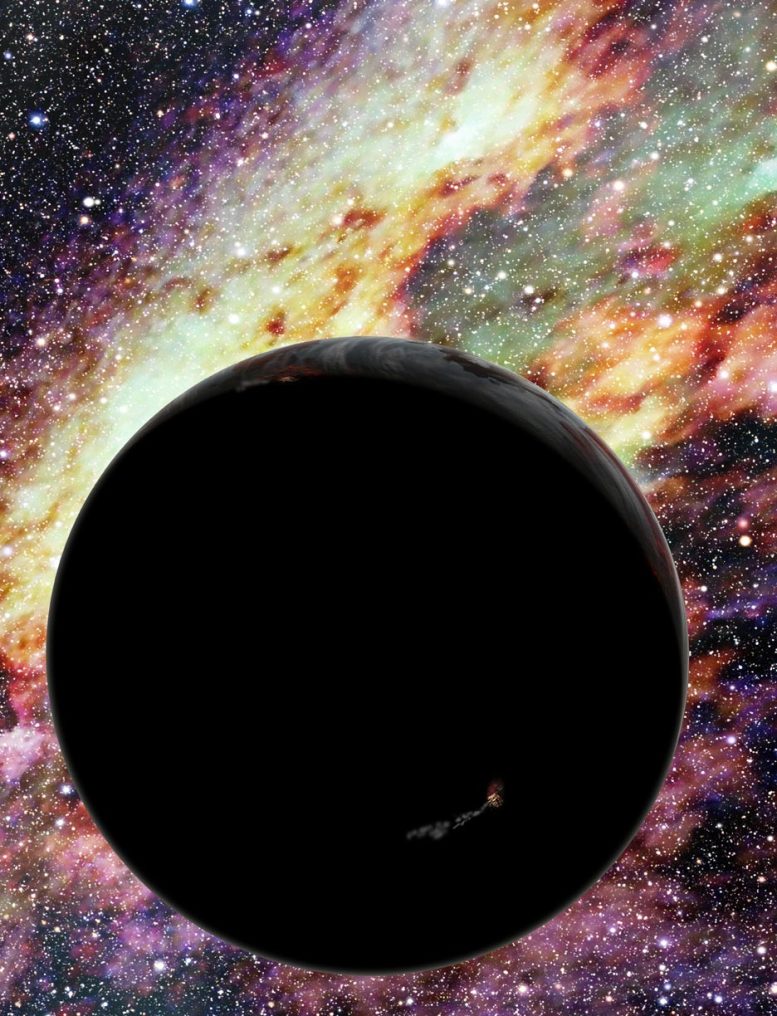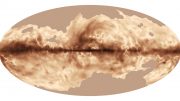
In this artist’s conception, a runaway planet zooms through interstellar space. New research suggests that the supermassive black hole at our galaxy’s center can fling planets outward at relativistic speeds. In this illustration, a glowing volcano on the planet’s surface hints at active plate tectonics that may keep the planet warm. Credit: David A. Aguilar/CfA
It’s hard to imagine planets that zip around at 30 million mph, but it was only a few years ago that astronomers found a “flying star” and now new research confirms that these runaway planets could be the fastest objects in our galaxy.
Seven years ago, astronomers boggled when they found the first runaway star flying out of our galaxy at a speed of 1.5 million mph (2.4 million kph). The discovery intrigued theorists, who wondered: If a star can get tossed outward at such an extreme velocity, could the same thing happen to planets?
New research shows that the answer is yes. Not only do runaway planets exist, but some of them zoom through space at a few percent of the speed of light — up to 30 million mph (48 million kph).
“These warp-speed planets would be some of the fastest objects in our galaxy. If you lived on one of them, you’d be in for a wild ride from the center of the galaxy to the universe at large,” said astrophysicist Avi Loeb of the Harvard-Smithsonian Center for Astrophysics.
“Other than subatomic particles, I don’t know of anything leaving our galaxy as fast as these runaway planets,” added lead author Idan Ginsburg of Dartmouth College.
Such speedy worlds, called hypervelocity planets, are produced in the same way as hypervelocity stars. A double-star system wanders too close to the supermassive black hole at the galactic center. Strong gravitational forces rip the stars from each other, sending one away at high speed while the other is captured into orbit around the black hole.
For this study, the researchers simulated what would happen if each star had a planet or two orbiting nearby. They found that the star ejected outward could carry its planets along for the ride. The second star, as it’s captured by the black hole, could have its planets torn away and flung into the icy blackness of interstellar space at tremendous speeds.
A typical hypervelocity planet would slingshot outward at 7 to 10 million mph (11 to 16 million kph). However, a small fraction of them could gain much higher speeds under ideal conditions.
Current instruments can’t detect a lone hypervelocity planet since they are dim, distant, and very rare. However, astronomers could spot a planet orbiting a hypervelocity star by watching for the star to dim slightly when the planet crosses its face in a transit.
For a hypervelocity star to carry a planet with it, that planet would have to be in a tight orbit. Therefore, the chances of seeing a transit would be relatively high, around 50 percent.
“With one-in-two odds of seeing a transit, if a hypervelocity star had a planet, it makes a lot of sense to watch for them,” said Ginsburg.
Eventually, such worlds will escape the Milky Way and travel through the intergalactic void.
“Travel agencies advertising journeys on hypervelocity planets might appeal to particularly adventurous individuals,” added Loeb.
The research will be published in the Monthly Notices of the Royal Astronomical Society, in a paper authored by Idan Ginsburg, Avi Loeb, and Gary Wegner (Dartmouth College).
Reference: “Hypervelocity planets and transits around hypervelocity stars” by Idan Ginsburg, Abraham Loeb and Gary A. Wegner, 30 May 2012, Monthly Notices of the Royal Astronomical Society.
DOI: 10.1111/j.1365-2966.2012.20930.x









Be the first to comment on "Runaway Planets at 30 Million MPH"